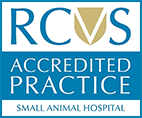Ultrasound is a widely used diagnostic imaging tool in veterinary medicine. It uses high-frequency sound waves to create real-time images of internal structures in the body. Advanced ultrasound requires the knowledge and application of advanced ultrasound machines and tools combined with years of additional training of the sonographer. Together, the application of these skills and kits enables the sonographer to diagnose conditions that are less commonly obtainable in general practice.
Advanced Ultrasound Applications:
- Doppler Ultrasound: This technique assesses blood flow within the body. In veterinary medicine, Doppler ultrasound can be used to evaluate blood vessels, assess cardiac function, and identify abnormalities in blood circulation, such as portosystemic liver shunts and abnormal growths within the body.
- Advanced Cardiac Ultrasound: Veterinary cardiologists may use advanced ultrasound techniques to assess cardiac function more comprehensively, including tissue Doppler imaging and strain imaging.
- Musculoskeletal Ultrasound: This involves evaluating soft tissues, joints, and muscles. It can be used to diagnose conditions such as tendon injuries, joint diseases, and soft tissue abnormalities.
- Ocular Ultrasound: Ultrasound can be used to assess the eyes and surrounding.
- Structures aiding in the diagnosis of ocular diseases or trauma.
- Contrast-Enhanced Ultrasound (CEUS): This involves the use of contrast agents to enhance the visibility of blood vessels and organs. CEUS can provide additional information about perfusion and vascularity, aiding in the diagnosis of certain conditions.
Advanced ultrasound non-invasive biopsy techniques
Ultrasound-guided biopsy techniques are valuable for obtaining diagnostic, precise, and targeted tissue samples, reducing the need for more invasive procedures. The choice of technique depends on the location and characteristics of the lesion, as well as the goals of the diagnostic evaluation. The procedures are typically performed under sedation, improving the speed of recovery time for our patients.
Ultrasound-guided biopsy techniques involve the use of ultrasound imaging to visualize and guide the biopsy needle to a specific target within the body. These techniques are commonly used in various medical specialities, including radiology, oncology, and interventional procedures. Ultrasound guidance enhances the precision and accuracy of biopsies, allowing for targeted sampling of tissues for diagnostic purposes. Here are some of the ultrasound-guided biopsy techniques we perform regularly at Brentknoll Vets Referrals:
- Fine Needle Aspiration (FNA):
- Procedure: A thin, hollow needle is inserted through the skin and into the targeted tissue. Cells or fluid are aspirated for examination under a microscope.
- Applications: FNA is often used for sampling cysts, palpable masses, or easily accessible lesions.
- Core Needle Biopsy (CNB):
- Procedure: A larger, spring-loaded biopsy needle is used to obtain a small core of tissue for examination. Multiple cores may be taken from different angles.
- Applications: CNB is commonly used for sampling solid masses, tumours, or lesions that require a more extensive tissue sample to obtain a diagnosis.
- Liver Biopsy:
- Procedure: Ultrasound is used to guide the FNA or CNB into the liver, ensuring accurate targeting of specific lesions.
- Applications: Used for evaluating liver diseases, such as viral, bacterial, inflammatory, auto-immune, cirrhosis or suspected tumours.
- Prostate Biopsy:
- Procedure: Ultrasound guidance is commonly used for prostate biopsies. The biopsy needle is directed into the prostate gland through the body wall.
- Applications: Used for diagnosing benign prostatic hyperplasia, prostatitis and prostatic cancers.
- Lymph node biopsy
- Procedure: Ultrasound guidance helps in targeting the superficial or deep lymph nodes of the body for biopsy. A biopsy needle is inserted through the skin into the lymph node.
- Applications: Used for diagnosing and evaluating lymph node enlargement to determine inflammatory or tumours. Used in the cancer staging process for selecting the correct surgical and chemotherapy options for patients.
- Deep soft tissue lump Biopsy:
- Procedure: Ultrasound-guided biopsies can be performed using FNA or CNB. The choice depends on the characteristics of the lesion.
- Applications: Used for evaluating deep soft tissue lumps that require ultrasound guidance to locate and obtain samples.
- Renal (Kidney) Biopsy:
- Procedure: Ultrasound guidance helps in targeting the kidney for biopsy. A biopsy needle is inserted through the skin into the kidney.
- Applications: Used for diagnosing and evaluating kidney diseases or tumours.
- Thyroid Biopsy:
- Procedure: Ultrasound is used to guide the biopsy needle into thyroid nodules. FNA is more commonly used for thyroid biopsy.
- Applications: Used for evaluating thyroid nodules to determine whether they are benign or malignant.
- Collaboration and Communication:
- Provide referral reports of logical and clear explanations of diagnoses, treatment options, and expected outcomes.
- Collaborate with internal & external referral teams and our primary care practitioners for a multidisciplinary approach to patient care.
Onsite facilities include:
- HD video Flexible Endoscopy and Bronchoscopy, Ridged rhinoscopy & arthroscopy
- Advance Ultrasound Machine (MylabX7VET) with touch-screen display
- Phillips IE 33 Colour Doppler ultrasound 1-12MHz probes. NHS standard
- 6-channel portable ECG
- Holter Monitors for 24-48 hour ECG Monitoring
- Doppler and oscillometric blood pressure monitoring
- CT Toshiba 64 slice with onsite Diagnostic imager
- Laparoscopy (keyhole) surgery kit
- Rehabilitation Centre with onsite chiropractic, hydrotherapy, underwater incline Treadmill & Class VI laser unit
- Regenerative medicine. We have the only veterinary-approved Companion Regenerative Therapies (CRT) System, including platelet-rich plasma (PRP) and bone marrow aspirate concentrate (BMAC).
- Separate cat, dog & exotic hospitalization wards for overnight care of weekday patients
What to expect from a Referral:
After receiving a referral request from the referring vet (either by email, fax or phone), our referral nurse will ensure we have the relevant history, referral letter and client information. We will then contact the client directly to arrange a suitable appointment time.
Referrals begin with a 30-minute appointment to fully examine the patient and discuss treatment plans thoroughly with the pet owner. A detailed Referral report, including findings, results and treatment recommendations, will be sent via email to your Primary Care Provider. The report is then discussed with you via your Primary Care Provider.
If follow-up procedures are required with ourselves, we will advise your Primary Care Provider of this within your pet’s reports. If you would like a copy of the report, this can be requested from us or your primary care provider.
Referral Online
To arrange a referral at Brentknoll Veterinary Centre, please complete our online referral form below or call us at 01905 355938. We look forward to meeting you and your pet!





